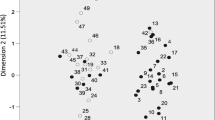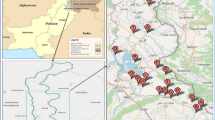Abstract
Forty-six accessions of grapevine (V. vinifera L.) were compared by restriction fragment length polmorphism (RFLP) analysis, and 111 informative or unique restriction fragments were found that revealed an important level of polymorphism. RFLP patterns were compared in two ways: by calculating electrophoretic similarity degree values further analyzed by principal component analysis and by studying the distribution of rare restriction fragments. Six taxonomic groups could be defined, which partially confirmed relationships derived from ampelographical data. Our data support the existence of ecogeographical groups.
Similar content being viewed by others
References
Bénin M, Gasquez J, Mahfoudi A, Bessis R (1988) Caractérisation biochimique des cépages de Vitis vinifera L. par électrophorèse d'isoenzymes foliaires: Essai de classification des variétés. Vitis 27:157–172
Bisson J (1986) Essai d'ampélographie génétique appliqué au Sauvignon autofécondé. Vigne Vini, Rivista Italiana di Viticoltura e di Enologia [Suppl] 12:63–65
Bouquet A (1982) Origine et évolution de l'encépagement français à travers les siècles. Prog Agric Vitic 5:110–120
Bourquin JC, Otten L, Walter B (1991) Identification of grapevine rootstocks by RFLP. CR Acad Sci Paris 312:593–598
Bourquin JC, Tournier P, Otten L, Walter B (1992) Identification of sixteen grapevine rootstocks by RFLP and RFLP analysis of nuclear DNA extracted from the wood. Vitis 31:157–162
Cecuk S (1955) Vitis sylvestris est-il progéniteur de Vitis vinifera? Prog Agric Vitic 143:37–45
Galet P (1962) Cépages et vignobles de France, vol 3: les cépages de cuve. Paysan du Midi press, Montpellier, France
Galet P (1990) Cépages et vignobles de France, vol 2: l'ampélographie française. C Dehan press, Montpellier, France
Gebhardt C, Ritter E, Debener T, Schachtschabel U, Walkemeier B, Uhrig H, Salamini F (1989) RFLP analysis and linkage mapping in Solanum tuberosum. Theor Appl Genet 78:65–75
Jelaska M (1956) La Récente Ampélographie de l'U.R.S.S. Prog Agric Vitic 145:278–282; 326–330
Jolliffe IT (1986) Principal component analysis. Springer, Berlin Heidelberg New York
Keim P (1989) Restriction fragment length polymorphism diversity in soybean. Theor Appl Genet 77:786–792
Levadoux L (1948) Les cépages à raisins de cuve. Prog Agric Vitic 129:6–14
Levadoux L (1954a) Les Lambrusques. Bull Soc Hortic Arboric Bouches-du-Rhône 10:12–15; 11:9–12
Levadoux L (1954b) La connaissance des cépages. Cahiers vitivinicoles de la revue Chambres d'agriculture [Suppl] 49:1–9
Levadoux L (1956) Les populations sauvages et cultivées de Vitis vinifera L. Ann Amélior Plant 6:59–117
Negrul AM (1938) Evolucija kuljturnyx form vinograda. Dokl Akad Nauk SSSR 8:585–588
Negrul AM (1946) Evropejskij i aziatskij vinograd V. vinifera L. Ampelografija SSSR Moscou 1:63
Negrul AM (1968a) Problems of grape origin and selection on the basis of genetics. Genetika 3:84–97
Negrul AM (1968b) Origin of cultivated grape. Dokl Timiryazevsk S-Kh Akad 139:329–338
Neuhausen SL (1992) Evaluation of restriction fragment length polymorphism in Cucumis melo. Theor Appl Genet 83:379–384
Powell W, Phillips MS, McNicol JW, Waugh R (1991) The use of DNA markers to estimate the extent and nature of genetic variability in Solanum tuberosum cultivars. Ann Appl Biol 118:423–432
Stavrakakis M, Loukas M (1983) The between-and withingrape-cultivars genetic variation. Sci Hortic 19:321–334
Striem MJ, Spiegel-Roy P, Ben-Hayyim G, Beckmann J, Gidoni D (1990) Genomic DNA fingerprinting of Vitis vinifera by the use of multi-loci probes. Vitis 29:223–227
Subden RE, Krizus A, Lougheed SC, Carey K (1987) Isozyme characterization of Vitis species and some cultivars. Am J Enol Vitic 38:176–181
Tedesco G, Gianazza E, Arigotti S, Cargnello G (1989) Wall proteins of Vitis vinifera pollen. II. Influence of the environment and rootstock on the electrophoretic pattern. Vitis 28:65–72
Viala P, Vermorel V (1901–1910) Traité général d'Ampélographie. Masson, Paris
Wolfe WH (1976) Identification of grape varieties by isozyme banding patterns. Am J Enol Vitic 27:68–73
Yamamoto N, Ono G, Takashima K, Totsuka A (1991) Restriction fragment length polymorphism of grapevine DNA with the phenylalanine ammonia-lyase cDNA. Jpn J Breed 41:365–368
Author information
Authors and Affiliations
Additional information
Communicated by G. Wenzel
Rights and permissions
About this article
Cite this article
Bourquin, J.C., Sonko, A., Otten, L. et al. Restriction fragment length polymorphism and molecular taxonomy in Vitis vinifera L.. Theoret. Appl. Genetics 87, 431–438 (1993). https://doi.org/10.1007/BF00215088
Received:
Accepted:
Issue Date:
DOI: https://doi.org/10.1007/BF00215088




